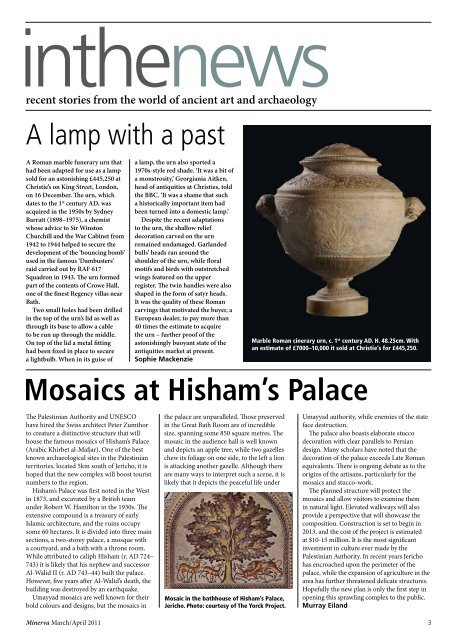Create successful ePaper yourself
Turn your PDF publications into a flip-book with our unique Google optimized e-Paper software.
inthenews<br />
recent stories from the world of ancient <strong>art</strong> and archaeology<br />
A lamp with a past<br />
A Roman marble funerary urn that<br />
had been adapted for use as a lamp<br />
sold for an astonishing £445,250 at<br />
Christie’s on King Street, London,<br />
on 16 December. The urn, which<br />
dates to the 1 st century AD, was<br />
acquired in the 1950s by Sydney<br />
Barratt (1898–1975), a chemist<br />
whose advice to Sir Winston<br />
Churchill and the War Cabinet from<br />
1942 to 1944 helped to secure the<br />
development of the ‘bouncing bomb’<br />
used in the famous ‘Dambusters’<br />
raid carried out by RAF 617<br />
Squadron in 1943. The urn formed<br />
p<strong>art</strong> of the contents of Crowe Hall,<br />
one of the finest Regency villas near<br />
Bath.<br />
Two small holes had been drilled<br />
in the top of the urn’s lid as well as<br />
through its base to allow a cable<br />
to be run up through the middle.<br />
On top of the lid a metal fitting<br />
had been fixed in place to secure<br />
a lightbulb. When in its guise of<br />
The Palestinian Authority and UNESCO<br />
have hired the Swiss architect Peter Zumthor<br />
to creature a distinctive structure that will<br />
house the famous mosaics of Hisham’s Palace<br />
(Arabic Khirbet al-Mafjar). One of the best<br />
known archaeological sites in the Palestinian<br />
territories, located 5km south of Jericho, it is<br />
hoped that the new complex will boost tourist<br />
numbers to the region.<br />
Hisham’s Palace was first noted in the West<br />
in 1873, and excavated by a British team<br />
under Robert W. Hamilton in the 1930s. The<br />
extensive compound is a treasury of early<br />
Islamic architecture, and the ruins occupy<br />
some 60 hectares. It is divided into three main<br />
sections, a two-storey palace, a mosque with<br />
a courtyard, and a bath with a throne room.<br />
While attributed to caliph Hisham (r. AD 724–<br />
743) it is likely that his nephew and successor<br />
Al-Walid II (r. AD 743 –44) built the palace.<br />
However, five years after Al-Walid’s death, the<br />
building was destroyed by an e<strong>art</strong>hquake.<br />
Umayyad mosaics are well known for their<br />
bold colours and designs, but the mosaics in<br />
a lamp, the urn also sported a<br />
1970s-style red shade. ‘It was a bit of<br />
a monstrosity,’ Georgiania Aitken,<br />
head of antiquities at Christies, told<br />
the BBC. ‘It was a shame that such<br />
a historically important item had<br />
been turned into a domestic lamp.’<br />
Despite the recent adaptations<br />
to the urn, the shallow relief<br />
decoration carved on the urn<br />
remained undamaged. Garlanded<br />
bulls’ heads ran around the<br />
shoulder of the urn, while floral<br />
motifs and birds with outstretched<br />
wings featured on the upper<br />
register. The twin handles were also<br />
shaped in the form of satyr heads.<br />
It was the quality of these Roman<br />
carvings that motivated the buyer, a<br />
European dealer, to pay more than<br />
40 times the estimate to acquire<br />
the urn – further proof of the<br />
astonishingly buoyant state of the<br />
antiquities market at present.<br />
Sophie Mackenzie<br />
the palace are unparalleled. Those preserved<br />
in the Great Bath Room are of incredible<br />
size, spanning some 850 square metres. The<br />
mosaic in the audience hall is well known<br />
and depicts an apple tree, while two gazelles<br />
chew its foliage on one side, to the left a lion<br />
is attacking another gazelle. Although there<br />
are many ways to interpret such a scene, it is<br />
likely that it depicts the peaceful life under<br />
Marble Roman cinerary urn, c. 1 st century AD. H. 48.25cm. With<br />
an estimate of £7000–10,000 it sold at Christie’s for £445,250.<br />
Mosaics at Hisham’s Palace<br />
Mosaic in the bathhouse of Hisham’s Palace,<br />
Jericho. Photo: courtesy of The Yorck Project.<br />
Umayyad authority, while enemies of the state<br />
face destruction.<br />
The palace also boasts elaborate stucco<br />
decoration with clear parallels to Persian<br />
design. Many scholars have noted that the<br />
decoration of the palace exceeds Late Roman<br />
equivalents. There is ongoing debate as to the<br />
origins of the <strong>art</strong>isans, p<strong>art</strong>icularly for the<br />
mosaics and stucco-work.<br />
The planned structure will protect the<br />
mosaics and allow visitors to examine them<br />
in natural light. Elevated walkways will also<br />
provide a perspective that will showcase the<br />
composition. Construction is set to begin in<br />
2013, and the cost of the project is estimated<br />
at $10-15 million. It is the most significant<br />
investment in culture ever made by the<br />
Palestinian Authority. In recent years Jericho<br />
has encroached upon the perimeter of the<br />
palace, while the expansion of agriculture in the<br />
area has further threatened delicate structures.<br />
Hopefully the new plan is only the first step in<br />
opening this sprawling complex to the public.<br />
Murray Eiland<br />
<strong>Minerva</strong> March/April 2011 3

















